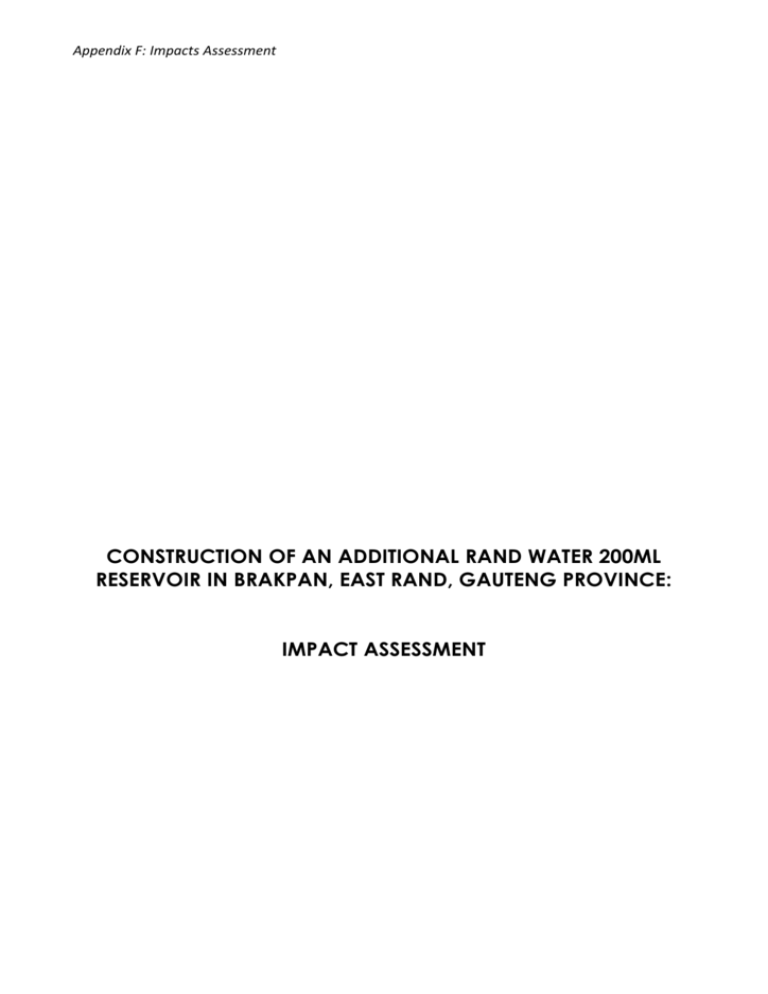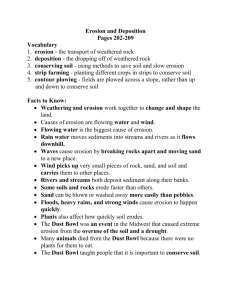APPENDIX F: Impact Assessment - Sazi Environmental Consulting
advertisement

Appendix F: Impacts Assessment CONSTRUCTION OF AN ADDITIONAL RAND WATER 200ML RESERVOIR IN BRAKPAN, EAST RAND, GAUTENG PROVINCE: IMPACT ASSESSMENT The assessment of impacts will largely be based on the Department of Environmental Affairs and Tourism’s (1998) Guideline Document: Environmental Impact Assessment Regulations. The assessment will consider impacts arising from the proposed decommissioning activities of the project both before and after the implementation of appropriate mitigation measures. The impacts will be assessed according to the criteria outlined in this section. Each issue is ranked according to extent, duration, magnitude (intensity) and probability. From these criteria, a significance rating is obtained, the method and formula is described below. Where possible, mitigation recommendations have been made and are presented in tabular form. The criteria given in the tables below will be used to conduct the evaluation. The nature of each impact was to be assessed and described in relation to the extent, duration, intensity, significance and probability of occurrence attached to it. Table 1: Impact assessment methodology Status of Impact The impacts are assessed as either having a: negative effect (i.e. at a `cost' to the environment), positive effect (i.e. a `benefit' to the environment), or Neutral effect on the environment. Extent of the Impact (1) Site (site only), (2) Local (site boundary and immediate surrounds), (3) Regional (within the City of Johannesburg), (4) National, or (5) International. Duration of the Impact The length that the impact will last for is described as either: (1) immediate (<1 year) (2) short term (1-5 years), (3) medium term (5-15 years), (4) long term (ceases after the operational life span of the project), (5) Permanent. Magnitude of the Impact The intensity or severity of the impacts is indicated as either: (0) none, (2) Minor, (4) Low, (6) Moderate (environmental functions altered but continue), (8) High (environmental functions temporarily cease), or (10) Very high / Unsure (environmental functions permanently cease). Probability of Occurrence The likelihood of the impact actually occurring is indicated as either: (0) None (the impact will not occur), (1) improbable (probability very low due to design or experience) (2) low probability (unlikely to occur), (3) medium probability (distinct probability that the Significance of the Impact Based on the information contained in the points above, the potential impacts are assigned a significance rating (S). This rating is formulated by adding the sum of the numbers assigned to extent (E), duration (D) and magnitude (M) and multiplying this sum by the probability (P) of the impact. S=(E+D+M)P impact will occur), (4) high probability (most likely to occur), or (5) Definite. The significance ratings are given below (<30) low (i.e. where this impact would not have a direct influence on the decision to develop in the area), 2|Page (30-60) medium (i.e. where the impact could influence the decision to develop in the area unless it is effectively mitigated), (>60) high (i.e. where the impact must have an influence on the decision process to develop in the area). The impacts of the proposed project were assessed and rated as follows: 1 CONSTRUCTION PHASE IMPACTS Direct Impacts: 1.1.1 Loss of biodiversity and habitat During construction some plants species may be removed on the proposed site footprint. No red data species have been detected or anticipated to occur on site. Most of the flora noted on site is heavily disturbed, with low alien infestation, however, very little natural vegetation is remaining along the proposed route. The fauna identified were birds, rodents, and other small flying and crawling insects. The impact on flora and fauna will be insignificant as very little vegetation will be removed to clear the site for construction. The proposed development is unlikely to have a significant negative impact on any threatened plant species or vegetation community, however, the following potential impacts on fauna and flora might occur as a result of the proposed project: Site preparation could result to loss of vegetation from the construction footprint; and Loss of habitat for animal species from the building footprint. Every effort must be made to minimize the disturbance to the surrounding vegetation. It is however noted that the scale of this development is not likely to have a significant impact on the biodiversity of the area or even within the property boundary. It is anticipated that the loss of biodiversity for the proposed site and its surroundings will be of a low negative significance due to the scale of the proposed development and the already disturbed nature of the proposed alignment. Implementation of the suggested corrective measures will ensure that this impact has a low level of significance. 3|Page 1.1.2 Soil erosion The loss of topsoil in South Africa is a national concern and thus erosion control must be taken seriously. Soil erosion may occur during the construction phase due to: Excavations Ineffective storm water management The impact will be limited due to the fact that the site has already been cleared due to past development activities; therefore any additional erosion is expected to be minimal. Provided that adequate soil erosion measures are implemented during the construction phase of the proposed activity, this impact can be deemed to be of low significance. Where soils are highly erodible, adequate measures must be implemented to prevent undue soil erosion. 1.1.3 Air pollution Construction activities on the site will lead to land clearing and disturbance of the soil resulting in dust creation. Potential air pollutant during construction may result from dust emanating from site preparation and excavations. Furthermore movement of construction vehicles also represents temporary, but important sources of particulates and dust deposition that can be respired. Given the nature and magnitude of the proposed project it is anticipated that minor dust will be generated from the construction activities. The potential impact on air quality will be short term and can be controlled. Proper implementation of recommended corrective measures will reduce the impact to become insignificant and of very low probability. It is therefore anticipated that this impact will be limited and of low negative significance. 1.1.4 Noise pollution There will be an increase in noise levels during the construction period. There are no major sources of noise adjacent to the site. Noise from construction vehicles, machinery, workers can be a nuisance during the construction phase. The level of noise and the distance it will travel will depend entirely on the prevailing construction activities within the site. An increase in noise is expected due to construction, which might have an impact especially on the neighbouring schools and residential settlements. Noise associated with the construction activities can be mitigated by limiting the construction operation to business, during which noise will not be of such a big concern to surrounding residents. The impact of noise will also be reduced to almost insignificant levels given the small scale of the development. 4|Page 1.1.5 Employment Creation The construction requires input from various individuals, resulting in employment opportunities for such persons. This employment would include direct opportunities for Contractors, Engineers, Project Managers and Planners. The project will yield opportunities for skilled and unskilled labour, although minimal. The extent and magnitude of this impact is relatively low and short term in duration compared to the other economic impacts, and is typically restricted to a limited number of skilled individuals. The significance is rated as medium and no mitigations were identified for this project. All the identified alternatives are likely to result in the same level of significance for this impact. Only the No-go Alternative would differ in that this impact would not occur. 5|Page Appendix F: Impacts Assessment IMPACT IMPACT RATING CRITERIA SIGNIFICANCE MITIGATION Vegetation clearing must be limited to areas to be occupied by the development footprint. Where possible large trees must be left intact. No hunting and killing of fauna is allowed. Only indigenous plant species must be planted in areas where rehabilitation is required. Implementation of anti-erosion measures such as the construction of berms to reduce the water velocity is essential. Storm water runoff shall be considered and its flow controlled at the construction site. In the event of significant erosion occurring, adequate corrective measures must be implemented to prevent any further soil loss. Unnecessary clearing of vegetation must be avoided. All exposed surfaces subjected to dust generation must be managed with appropriate dust suppression methods including amongst others, the use of water tankers etc. Vehicles travelling on the site must not be allowed to reach sufficient speeds so as to cause dust to rise from the roads. It must be ensured that all vehicles used during construction are appropriately maintained. Surrounding residents must be notified in advance of construction schedules. Working hours must be restricted to daytime only (8am – 5pm). NATURE EXTENT DURATION MAGNITUDE PROBABILITY Loss of biodiversity and habitat negative 1 5 3 5 45 - Medium Soil erosion Negative 2 2 6 2 20 - Low Air pollution Negative 2 1 4 4 26 - Low Noise pollution Negative 2 1 4 3 21 -Low Should there be a need for the contractor to work overtime, neighbours must be informed. Employment creation Positive 3 2 8 4 30-60 Medium 7|Page Appendix F: Impacts Assessment






